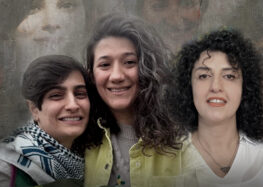Women’s Education
In addition to national legislation, the state has moved forward with other initiatives that restrict women’s ability to participate in public life. Most notably, the state has promoted gender-based university admissions policies that are highly discriminatory to women.
Ironically, the Islamic Republic has long pointed to the expansion of women’s education as one of its crowning achievements. Yet the success of female education in Iran, especially the expansion of women’s university attendance, triggered a reactionary backlash that came to fruition under the (previous) hardline administration of Mahmoud Ahmadinejad.
Conservative government officials and clerics came to view female education as a threat to traditional Islamic values, particularly regarding commitment to the family and willingness to marry and bear children. They linked university-level education and the professional opportunities it created to an increasing divorce rate and plummeting fertility rate. Restricting women’s access to areas of study in higher education thus became a policy priority.
As Ayatollah Ahmad Jannati, the Chairman of the Guardian Council, the body that vets candidates for political office and approves legislation passed by Parliament, said at Tehran Friday prayers in November 2008, “One of the problems women’s university education has caused for us is that when suitors seek their hand in marriage, perhaps the first question asked is his educational level. …[Women] should know that they are destroying their own lives and the country will also face problems as a result of the increased marriage age,” he said. “Women’s university education has become problematic.”
The primary means the Ahmadinejad administration used to promote gender-based admission policies was through the Ministry of Science, which installs the heads of universities. There are 76 government-affiliated universities in Iran whose heads are directly appointed by this ministry and thus chancellors who were willing to implement gender–based admissions policies were installed in universities throughout the country.
In August 2012, a Mehr News Agency report found that women were now prevented from admission in 77 majors in 36 universities, including such areas as accounting, education, advising and counseling, historical restoration, chemistry, and engineering. The Mehr report found that Mohaghegh Ardabili University had 24 majors restricted to men, Lorestan University had 18 majors, and the Imam Khomeini International University had 15 male-restricted majors. These three universities had the highest number of men-only majors. Civil Engineering and Topographical Survey, and two-year Civil Engineering majors comprised the largest men-only majors in 15 universities, followed by Management groups, and then Mine Engineering in 12 universities.
In an August 9, 2014 article on the issue, Etemad Newspaper wrote, “A review of the 2014 Entrance Exam booklet shows that Shiraz University [one of Iran’s major universities] and Mohagheh Ardabili University are leaders in gender quotas. In almost all majors in the four humanities, physical science, math, and arts disciplines, these universities have implemented this [gender-quota] policy.” The report continued, “Shiraz University has implemented gender quotas in 60 majors, increasing the quota for male admissions in 36 majors, doubling the male admission quotas in three majors, and equal quotas in 21 majors. In the two majors of Biosystem Mechanical Engineering and Islamic Theology, women were completely eliminated. Details of announced capacities indicate that Shiraz University has allocated a higher capacity for men in all the majors under the pilot group of Math Sciences and Technology. In its Biosystem Mechanical Engineering Major, this university has allocated its entire capacity of 20 to men, and in Statistics, Math, Physics, Electrical Engineering, Urban Planning, Mechanical Engineering, Architecture, Material Science Engineering, and Petroleum Engineering majors, it admitted almost twice as many men. In Tourism Management major under its Mathematical and Technical Sciences sub-group, Shiraz University has allocated twice as many spots for women. In 40 of its majors, Mohaghegh Ardabili University has allocated double quotas for men.”
During his campaign, Rouhani directly criticized the gender-based university admissions policies (as well as gender-based employment policies promoted by hardliners), stating, “They did not ask people’s opinion. This is an unprofessional plan. In our constitution there is no mention of gender segregation…. The next government will not discriminate between men and women who are seeking employment opportunities.”
Yet since coming into office, Rouhani has faced vehement hardline opposition to any rollback of gender-based quotas, and has not been able to enact significant change. “The Ministry of Science considers gender quotas in the University Entrance Examination admissions against educational justice. The Ministry of Science does not believe in general quotas in nationwide University Entrance Examination, and one of the new policies for the Ministry is to eliminate them,” said Jafar Tofighi, Advisor to the Minister of Science in April 2014. Yet he was forced to retract his statement the next day. “My statements yesterday about gender quotas in universities, were only my personal views and do not represent the Ministry of Science’s views,” he told ISNA, he told ISNA. “So far, gender quotas are not on the Ministry of Science’s agenda. Decision-making about university gender quotas is a subject that will be put on the Science Ministry’s agenda when necessary.”
While Rouhani has replaced 49 out of the 76 state-affiliated university heads with individuals in line with the administration’s more centrist view on women, the universities have been under intense pressure to maintain conservative policies. Hardliners have attacked the re-hiring and re-admittance of professors and students who had been banned for political reasons from studying at university under the previous administration, and have vehemently fought against the removal of gender-based admission quotas. Rouhani’s first four choices for the Minister of Science and Higher Education were not approved by Parliament; while his fifth choice was finally approved, he was impeached a few months later.
Drawing a direct connection between education and employment opportunities considered undesirable for women, Grand Ayatollah Jafar Sobhani, a leading cleric from Qom, said at a meeting with Payam-e Nour University Chancellor on April 25, 2014, “It is not necessary for all women to attend the university, because this will cause expectations in the employment field, as well.”
In a speech on April 19, 2014, Iran’s Supreme Leader, Ayatollah Seyed Ali Khamenei made it clear that gender-based university admissions were carried out with his full support: “There are some professions that are not commensurate with a woman’s make, so they shouldn’t pursue those. One thing to do is not to impose on women [an] education that leads to those jobs. On the issue of universities and education, some make a lot of noise about discrimination in education; such discrimination is not a bad thing everywhere…this discrimination is justice itself…. [Therefore,] based on those high goals, we must look to see what studies are suitable for women, and make those studies available to them. Just because she participated in the University Entrance Exam, or because she scored a certain score, we must not force her to study a certain major which may not be compatible with her feminine nature, nor compatible with her high goals, and where the jobs she will be offered as a result of these studies are not compatible with her.”
The ramifications of these quotas are significant. Women are banned from receiving the training that is required to enter numerous fields, thereby preventing them from employment in these areas. Their professional opportunities will be limited, in violation of Iranian and international laws that prevent discrimination on the basis of gender.




